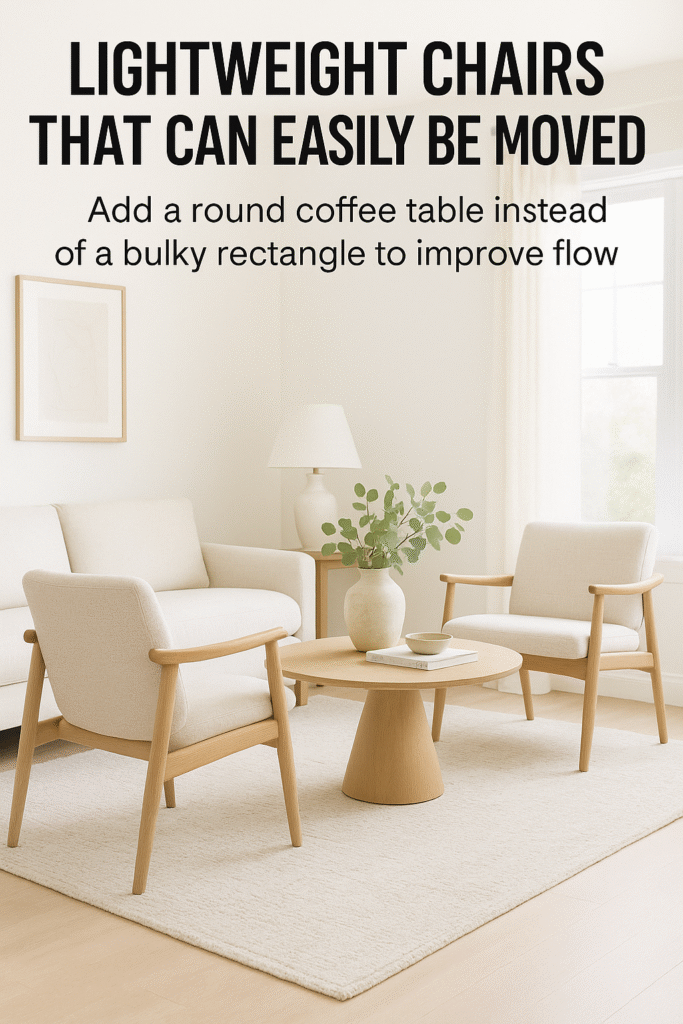7 Small Space Living Room Layouts That Actually Work
Small living rooms often get a bad reputation for being tricky to decorate — but the truth is, with the right layout, even the tiniest space can look stylish and feel functional. The secret is maximizing flow, choosing multi-purpose furniture, and using clever placement to open up the room.
Here are 7 small space living room layouts that actually work in real homes — each designed to save space, look beautiful, and make everyday life more convenient.
The Conversation Hub
What it is: Arrange your sofa and two chairs around a small coffee table, forming a cozy square or circle.
Why it works: This setup naturally encourages conversation, making even a small space feel warm and social.
Convenience factor: Perfect for people who love hosting friends or family but don’t have room for a large sectional. It keeps the energy focused inward, and no seat feels left out.

2. The Floating Sofa
What it is: Instead of pushing your sofa against the wall, “float” it a few feet into the room with a slim console table or shelving behind it.
Why it works: It creates breathing room around the walls, tricks the eye into seeing more space, and gives you extra surfaces for décor.
Convenience factor: Ideal for open-concept apartments where you need to define zones (like separating the living area from the dining area).
How to apply it: Use a console table with baskets for storage or styling. Anchor the look with a rug that’s large enough to sit under all major furniture pieces.
3. The Diagonal Trick
What it is: Angle your sofa or chairs diagonally across the room instead of keeping everything straight.
Why it works: It breaks up boxy layouts, softens corners, and makes the room feel instantly more dynamic.
Convenience factor: Perfect if your living room doubles as a walkway — the angled placement naturally guides foot traffic.How to apply it: Start with your largest piece (usually the sofa), place it at a soft angle, and fill in the corners with plants, shelves, or a floor lamp.
4. The Dual-Purpose Layout
What it is: Position your sofa toward the TV or fireplace, but add a desk, dining nook, or console table right behind it.
Why it works: It allows one room to serve multiple functions without feeling cramped.
Convenience factor: Essential for studio apartments or small homes where your living room needs to work overtime.
How to apply it: Choose a desk or table that’s the same width as your sofa for a seamless look. Add stylish storage baskets underneath for hidden organization.
5. The Window Focal Point
What it is: Arrange your seating so that it frames your biggest window, instead of defaulting to the TV wall.
Why it works: Natural light instantly makes small rooms feel airy and expansive, and the window becomes the star.
Convenience factor: This layout is perfect for book lovers, coffee sippers, and anyone who loves relaxing in natural light.How to apply it: Place your sofa opposite the window to soak in the view. Keep window treatments light (sheer curtains or roman shades) so you don’t block the openness.
6. The Wall-to-Wall Bench + Sofa
What it is: Use a slim sofa and a built-in or freestanding bench along one wall instead of bulky armchairs.
Why it works: It maximizes seating without eating up floor space, and benches double as extra storage if you choose ones with lids or drawers.
Convenience factor: Perfect for small households that host occasionally — extra seating only takes up space when needed.
How to apply it: Choose a bench with hidden storage. Style with oversized cushions to make it cozy. Pair with a nesting coffee table that can expand when entertaining.
7. The Media Wall Layout
What it is: Balance your TV or fireplace by flanking it with shelving, built-ins, or vertical storage.
Why it works: It creates a strong focal point, reduces visual clutter, and makes the room feel designed instead of cramped.
Convenience factor: Especially good for families who need both entertainment and storage — toys, books, or décor can live right beside the TV.How to apply it: Use vertical shelving to draw the eye upward. Keep décor light (baskets, plants, a few books) so it doesn’t overwhelm the space.
